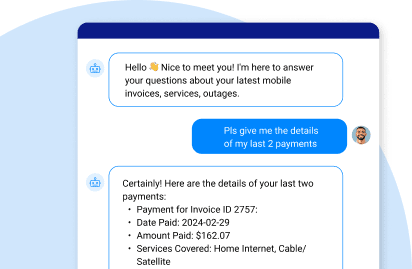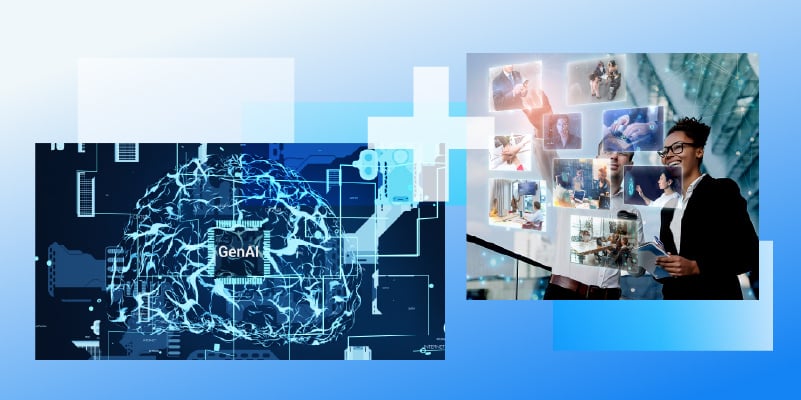LLM graph databases merge LLMs with graph DBs to enable natural language querying, enriched data insights, and deeper understanding of data relationships.
What is an LLM graph database?
An LLM graph database is the fusion of two powerful technologies: Large Language Models (LLMs) and graph databases. But what exactly does that mean?
An LLM is trained on vast amounts of text and data enabling it to understand and generate human-like language – and making them incredibly useful for tasks like answering questions, generating content, and interpreting text-based data.
An enterprise LLM is typically used in conjunction with generative AI (GenAI) frameworks, like Retrieval-Augmented Generation (RAG). RAG injects your enterprise data into your LLM prompts, enabling more accurate and personalized responses from your GenAI apps.
A graph database stores data in the form of graphs, which consist of nodes (representing entities) and edges (representing the relationships between those entities). This type of database is excellent for handling complex, interconnected data – making it ideal for generative AI use cases in customer service, like RAG chatbot applications.
An LLM graph database starts with the intuitive querying power of a graph database but enhances it with the language processing capabilities of an LLM. This combination enables users to ask questions or interact with data in natural language – with the system providing meaningful insights based on the relationships and patterns in the graph data.
Thus, an LLM graph database makes it possible to combine the structured, interconnected nature of graph databases with the sophisticated, language-based processing power of GenAI. The result? Smarter, more intuitive ways to manage and query data.
Benefits of LLM graph databases
LLM graph databases offer a wealth of benefits to organizations looking to leverage their data in smarter, more efficient ways, notably:
-
Enhanced data understanding
One of the key strengths of an LLM graph database is its ability to improve how we understand complex data. Traditional databases can’t analyze interconnected data very well, but with a graph structure, you can see exactly how data points relate to one another. When combined with a large language model, this data can be interpreted more naturally. The LLM recognizes patterns and offers insights in ways that are more intuitive for users to understand – making it easier to uncover trends and relationships that may not be immediately obvious.
-
Improved querying and search
In a standard graph database, querying data requires technical know-how. But, with an LLM graph database, users can interact with the data in plain English. For example, you could ask, “What are the most common connections between customers and products in this dataset?” The system would then interpret that question and return relevant insights. This ease of use makes it far simpler for non-technical users and speeds up the process of data exploration.
-
Better insights
LLMs excel at processing and synthesizing information, which is particularly useful in a graph database environment. With an LLM graph database, AI models can analyze the relationships between data points in detail, allowing businesses to make data-driven decisions based on comprehensive, interconnected information. Whether it’s predicting future trends, discovering hidden relationships, or uncovering outliers, the LLM adds a layer of intelligence that enhances decision-making.
-
Scalability
One of the biggest challenges with traditional databases is scalability. As data grows, so does the complexity of managing it. Graph databases naturally handle complex, connected data more efficiently than relational databases. When paired with the power of LLMs, this scalability is taken to the next level. LLM graph databases can process massive datasets while maintaining fast, accurate, and accessible responses – making them ideal for businesses dealing with large volumes of dynamic data.
How LLM graph databases transform industries
LLM graph databases are already making a significant impact across various industries by offering new ways to manage, analyze, and act on data. The ability to process and understand relationships between complex data points helps industries tackle challenges in ways that weren’t possible before. For example:
-
Customer Relationship Management (CRM)
In the world of CRM, understanding and predicting customer behavior is crucial. LLM graph databases help businesses analyze customer interactions in a much more connected and dynamic way. They allow businesses to create personalized experiences at scale by processing vast amounts of customer data like purchasing behavior, preferences, and even social media activity. By more accurately mapping the relationships between customers, products, and services, businesses can anticipate needs better and improve customer satisfaction.
-
Fraud detection
Fraud is a major concern, especially for industries like banking, e-commerce, and insurance. Traditional methods of detecting fraud can be time-consuming and require a human in the loop. LLM graph databases can analyze vast networks of transactions in real time and identify suspicious patterns or anomalies. By examining the relationships between accounts, transactions, and behaviors, they can flag potentially fraudulent activity much faster than manual processes.
-
Healthcare
In healthcare, data is everywhere – in patient records, medical research, treatment histories, and more. But until now, healthcare data has often been fragmented and siloed, which makes it difficult to draw meaningful connections. LLM graph databases allow medical professionals to create a comprehensive, interconnected view of patient data. By linking patient histories with research papers, clinical trials, and treatment outcomes, healthcare providers can make better-informed decisions.
-
Supply chain and logistics
In industries like retail and manufacturing, supply chain optimization is key to maintaining efficiency and reducing costs. LLM graph databases enable businesses to get a clearer picture of their supply chain operations by analyzing the relationships between suppliers, products, transportation routes, and inventory levels. Now, companies can leverage AI-driven insights to predict delays, optimize routes, and even foresee potential disruptions.
Integrating TAG with LLM and Graph Databases
By leveraging Table-Augmented Generation (TAG), organizations can enhance the capabilities of LLMs working with graph databases by enabling direct access to multi-source database tables. TAG makes it easier to pull together dispersed data, so the LLM can generate insights or answers that reflect the most current and comprehensive information available. This method helps create deeper connections within the data, letting the LLM surface relationships and provide context-rich outputs. Using TAG alongside graph databases means LLMs can deliver responses that take full advantage of both connected data structures and up-to-date information spread across different systems. When paired with agentic RAG, this setup empowers LLMs to not only retrieve relevant information but also autonomously determine the next best action—based on the relationships mapped in the graph and contextual insights from your enterprise data.
K2view unleashes the power of LLM graph databases
K2view’s RAG tool, GenAI Data Fusion, supports LLM graph databases with chain-of-thought prompting – helping them query your LLM more effectively and deliver more accurate and contextually relevant responses more quickly. It creates dynamic queries based on multi-source enterprise data, making it easier for users to retrieve accurate information quickly. This approach improves graph database-driven applications by:
-
Integrating real-time data about specific customers or business entities directly into graph database queries.
-
Dynamically masking sensitive or PII (Personally Identifiable Information) during query execution. To ensure this data orchestration is consistent, secure, and explainable, organizations can implement a Model Concept Protocol (MCP). MCP provides a structured framework for defining how data models, business entities, and query logic interact within LLM-powered systems—enabling more predictable outcomes and governance in graph-aware AI pipelines.
-
Efficiently handling data service access requests and providing intelligent recommendations like cross-sell opportunities.
-
Aggregating data from diverse source systems by accessing enterprise graph databases via API, CDC, messaging, or streaming.
The fusion of agentic RAG, MCP, and LLM graph database technologies is redefining how enterprises access, interact with, and act upon their most complex and connected data.
Discover K2View GenAI Data Fusion, the RAG tool
with full support for LLM graph databases.












